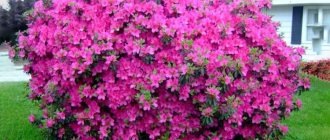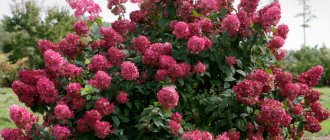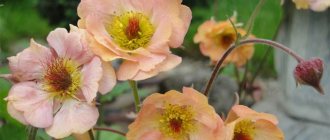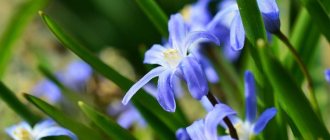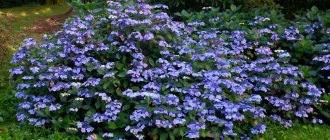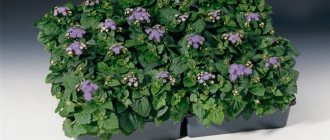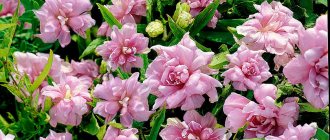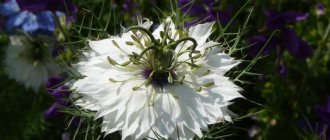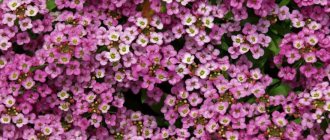Nivyanik (the official name is leucanthemum, the popular name is garden chamomile) is an annual or perennial herbaceous plant belonging to the Asteraceae family. The stem is straight, reaches a height of 30-100 cm, and branches. Obovate, oblong leaves are attached to elongated petioles. They can be solid with jagged edges or pinnately dissected.
Flowering occurs at the end of June. Some varieties bloom twice a year: in late spring and late summer. An inflorescence-basket blooms at the top of the stem. The yellow core is framed by long snow-white or yellowish petals. The corolla is large: 6-12 cm in diameter. The inflorescences can be simple, double or semi-double - creating a resemblance to a snow globe. Flowering exudes a delicate aroma.
The fruit is a multi-seeded capsule with a one-sided crown at the top. There are about 650 seeds in 1 g of weight. The seeds are oblong and remain viable for about 3 years.
In its natural environment, cornflower covers the meadows and fields of Southern Europe.
Thanks to its touching appearance coupled with its ease of care, nivaria has become a popular garden crop.
Growing cornflower from seeds When to plant cornflower
Nielberry seeds photo
Nivyanik is propagated by seeds and vegetatively.
When to sow in open ground
Sowing in open ground is carried out in the spring from the end of March to the end of April or in late autumn . In the first case, the seeds will germinate in a couple of weeks, and by the end of summer you will get strong plants that will bloom next season. In the second option, the seeds will sprout in the spring and flower in the same summer.
Shoots of cornflower sown before winter photo
- Plant the seeds not deeply (no more than 2 cm) and as rarely as possible.
- The distance between rows is 25-30 cm.
- Crops can be watered without stagnant water, so that an earthen crust does not form.
- When the seedlings appear, they need to be carefully broken through, leaving 8-10 cm between the seedlings.
- If the seeds are purchased and it’s a pity to throw away the extra plants, replant them in a permanent place; even crumbs 3-4 cm tall are perfectly accepted if the soil is constantly moist.
- Plant grown young plants at a distance of about 40-50 cm from each other.
The first year or two the bushes will be small and compact. But keep in mind: with good care and daily watering, nevus can grow greatly, forming powerful bushes up to 80 cm in diameter and more than a meter in height.
How to grow seedlings at home When to plant
Cornflower for seedlings: when to plant photo of seedlings
If you grow seedlings, you can get flowering in the first year.
- Sowing seedlings in February-March.
- Fill the boxes or pots with light nutritious soil for seedlings, plant the seeds to a depth of 1 cm, water, cover the crops with film or glass.
- If you don’t want to plant the plants later, take the trouble to plant the seeds one at a time in cassette cups.
- Maintain the air temperature within 22°C, provide diffuse lighting, ventilate the greenhouse daily, and periodically moisten the soil.
- Expect the emergence of seedlings in 15-20 days - then the cover should be removed.
- Grow at an air temperature in the range of 17-20°C, leave the lighting the same.
- When 3 true leaves appear, plant them in separate containers. Soil: sand-peat mixture with the addition of leaf humus.
- Water moderately and provide good lighting.
- They begin to harden the grown seedlings from the beginning of May, taking them outside. First, choose a shaded place without wind, and then you can put it in an open area lit by the sun. This way the plants will be well prepared for planting in the ground and will not get sick.
Plant in open ground in mid-May, in the absence of night frosts. Plant at a distance of 40-50 cm, observing the level of the root collar.
Crazy Daisy chamomile from seeds. What are there: popular varieties
There are a wide variety of varieties of double chamomile (Nivyanika), which differ in flower shape and inflorescence diameter. The most common are the following: “Aphrodite”, French chamomile “Edelweiss”, Crazy Daisy, Polish, “Aglaya”, “Alaska” and others. Let's look at some of them in more detail.
- Terry chamomile "Aphrodite". Its flowers are bright, contrasting, and will fit perfectly into the landscape of any flower garden. This is a perennial flower that has many narrow, curling, snow-white leaves. The stem grows up to 80 cm in height. “Aphrodite” begins to bloom in July and continues to delight the owner’s eye until September. Ideally combined in a composition with other flowers in the garden, the diameter of the flower reaches up to 10 cm. Loves sunbathing, tolerates winter under a little insulation.
- Terry chamomile (Nivyanik) Crazy Daisy. This plant has double snow-white flowers. The stem grows up to 70 cm, the petals are quite strongly dissected. It grows well in loose soils, where there is a lot of light, and it requires a spacious flowerbed. This delightful plant with large inflorescences needs moderate watering, a little more often during drought. He loves feeding very much, mineral and organic fertilizers are especially suitable. Crazy Daisy seeds should be planted in a greenhouse in the spring, and in open ground in July. After the first color fades, the branches should be cut off, then new flowers will appear in their place.
- French chamomile "Edelweiss". This plant is quite winter-hardy and prefers moist soil. It is planted immediately in open ground from May to June. The seedlings are transplanted to the place of direct growth in August, and it is necessary to maintain a distance between plants: it should be 25-30 cm. The inflorescence of “Edelweiss” is 10-12 cm. The flowers are very similar to chrysanthemums, fluffy, double. The unusual thing about this variety is that it continues to flower until the onset of frost.
Nivyaniki are very beautiful!
How to care for nevus in the open ground
Nivenik planting in open ground and care Pictured is the variety Snow Lady Snow Lady
Choosing a landing site
To ensure abundant flowering, select a well-lit area for planting the plant, possibly with slight shading. Due to lack of lighting, the stems will stretch and bend, and there will be few flowers.
Priming
The soil needs to be loose, fertile, light. Chernozems or loams of neutral and slightly acidic reaction are ideal. Too acidic soil is contraindicated. It grows poorly on clay and sandy soils. When planting under digging, add peat, compost, and humus.
How to water
Water regularly, do not allow water to stagnate. In case of drought, add about 10 liters of water under each bush. To retain moisture, mulch the soil with sawdust, wood chips or pine needles.
Feeding
You can feed it twice a month, alternating mineral fertilizers with organic matter. You can apply complex mineral fertilizers, nitrophoska; from organic matter, mullein infusion is preferred. However, it is worth noting that the plant does well without fertilizing at all in ordinary garden soil.
How to prolong flowering
If there is no need to collect seeds, cut off the inflorescences as they wilt - this will prevent the plant from losing vigor and stimulate re-blooming.
Preparing for winter
In the fall, prepare for wintering. After flowering is complete, shorten the stems, leaving about 10 cm with basal foliage. In most cases, much effort is not required: the plant does not freeze even in the absence of snow cover in winter. If in your area there are severe frosts of more than 20°C, it is better to cover the nevberry a little. Mulch with peat, additionally cover with fallen leaves and spruce branches. Remove the cover in early spring.
Care
Caring for the “crazy daisy” does not require any special skills, but still, unlike the Common Niwberry, the care of which can be approached “purely at will”, the “Magnificent” varieties still require attention and most importantly in this process:
- regular watering: more often on hot days, less often on cool days;
- weeding;
- periodic fertilizing with organic and mineral fertilizers;
- removing faded flowers;
- preparation for winter.
Nielweed has excellent resistance to disease, and of all the pests, only aphids and thrips “get it” the most.
All articles about Nivyanik on the site can be read by following this link: NIVYANIK
In general, when planting a flower like Crazy Daisy on your plot, be sure that it will not require any special attention, and the duration of flowering and the combination of garden chamomile with other plants will make it a pearl among flowers.
Types of cornflower with photos and names
About 70 species of cornflower live in the natural environment; some of them are cultivated.
Common cornflower or meadow chamomile Leucanthemum vulgare
Common cornflower or meadow chamomile Leucanthemum vulgare photo
The stem extends 60-80 cm. The diameter of the corolla reaches 8 cm, the flowers are simple. The leaves are glossy and have serrated edges. The plant is shade-tolerant and drought-resistant.
Varieties:
- Maxima Koenig - stem height is about 1 m, flowers are simple, corolla diameter is 12 cm;
- May Queen - stem up to half a meter long, semi-double flowers;
- Mastern - plant height is 60 cm.
Leucanthemum maximum
Leucanthemum maximum photo
The height of the plant is 50-100 cm. The leaves are sessile, oblong, with crenate edges. Blooms from early summer until autumn. The diameter of the corolla reaches 12 cm.
Varieties:
Alaska is a frost-resistant plant, the inflorescence diameter is 10 cm;
Snow Lady is an annual with very large flowers: the diameter reaches 17 cm, the core is lush, the petals are wide;
Wirral supreme – stems reach a height of 80 cm, flowers are semi-double;
Little Princess – bush 20-30 cm high, simple inflorescences;
Silver princess - the height of the stems is 40 cm. The bush is compact. The leaves are dark green, glossy. The inflorescences are simple, their diameter reaches 6 cm;
Broadway Lights - has medium-sized stems. The color of the petals is light yellow, the inflorescences are simple.
Leucanthemum superbum
Yellow cornflower variety leucanthemum banana cream photo
The height is 1 m. The stems are strong and erect. The basal leaf rosette consists of ovoid leaf plates about 30 cm long. Simple inflorescences with a diameter of 8-10 cm are pleasing in July-August. Frost-resistant plant - can withstand temperatures down to -29 °C.
Fiona Goghill is an interesting variety of magnificent cornflower. The stems stretch 75 cm. The inflorescences are double. The center is lush, has a lemon tint, towards the edges the petals are wider, painted creamy white.
Varieties most popular with gardeners
There are a large number of varieties of garden nivaria. There are varieties of terry perennial chamomile, and there are annual varieties with simple inflorescences. But only a few are the most popular. They differ from each other in the shape of the inflorescences, the height of the bush, and the duration of flowering.
Alaska
The most popular variety of large chamomile. The plant forms a bush 80 cm high. Inflorescences are up to 12 cm in diameter. The variety is unpretentious and drought-resistant. Seeds are planted in open ground in the fall so that the plant will enjoy flowering the following year.
Important! The first flowering occurs in the first half of June, the second occurs in the fall
Alaska
Princess
A low-growing variety that blooms throughout the warm period. The plant forms a small spreading bush up to half a meter high. Blooms profusely and for a long time with regular watering. Bush chamomile, at the beginning of summer the plant is covered with numerous inflorescences with a diameter of 10 cm. Against the background of short shoots, the flowers look quite large. Flowering lasts about a month, but to prolong flowering it is necessary to promptly pick off faded inflorescences.
Princess
North Star
The variety is considered a favorite among perennial garden daisies. The plant got its name because of its snow-white silver inflorescences-baskets with thin, pointed petals. When planted in a sunny place, the bush grows 16 cm wide and reaches a height of up to 40 cm. The variety is winter-hardy and easily tolerates Russian frosts.
North Star
Stern von Antwerp
The giant bush is covered with inflorescences 10 cm in diameter. The core of the flower is yellow, and the reed flowers are snow-white. For long-term flowering, the plant is planted in a sunny place with nutritious soil.
Stern von Antwerp
Beethoven
A perennial plant up to 80 cm high. In June, single, simple inflorescences-baskets measuring 12 cm in size appear on the bush. The flowers have snow-white petals and a golden core. The variety is suitable for cutting, single and group plantings.
Beethoven
Schwabengrub
The variety forms a huge bush 80 cm high. During flowering, the plant is covered with large, double flowers. The variety is winter-hardy and is grown in seedlings for rapid flowering.
Little Princess
The low-growing variety is suitable for decorating borders and edging flower beds. Chamomile is small, garden, reaches a height of 20 cm. The first flowering occurs in the second half of June, the second in August. The basket inflorescences reach 5 cm in diameter.
Maxima Koenig
Perennial herbaceous plant up to 1 meter high. The inflorescences are large, 10-12 cm in diameter, with a bright golden core and two-row snow-white reed petals. The variety blooms in June-July.
Maxima Koenig
Sans Souci
The plant forms a meter-long bush with 12 cm inflorescences. Around the yellow core there are white or yellow petals arranged in several rows. The variety is winter-hardy, propagated by seeds and by dividing the bush.
Sans Souci
May Queen
The variety is popular among Russian flower growers for its unpretentiousness and frost resistance. The compact bush reaches a height of up to half a meter. Against the background of dark olive glossy foliage, single snow-white basket inflorescences look attractive. It blooms 2 years after planting the seeds; to see early flowering, the variety is grown in seedlings.
May Queen
There are many flowers similar to the daisy, but they have different colored petals. Such plants include:
- feverfew, summer residents often call it perennial red chamomile;
- erigeron or perennial pink chamomile.
Important! These colored varieties will look harmonious in combination with garden chamomile. In addition, they have the same conditions of detention and rules of care.
The best varieties of cornflower with photos and names
Leucanthemum crazy daisy
Crazy daisy Leucanthemum crazy daisy photo
The amazing beauty of the Crazy Daisy terry chamomile with thin petals is comparable only to the beauty of the white chrysanthemum. Spectacular snow-white flowers will become a bright backdrop for colorful neighbors.
Leucanthemum giant Leucanthemum giant
Giant cornflower giant photo
Have you ever seen a daisy with a flower diameter of 12 cm? This splendor comes from the Giant variety, which is as easy to care for as an ordinary field chamomile: plant it and forget it. Unless in a severe drought it is worth taking care of the beauty so that it gives lush flowers.
Leucanthemum x superbum 'Silver Princess'
Leucanthemum x superbum 'Silver Princess' photo
The chamomile variety Silver Princess is distinguished by the depth of color of its dark green leaves with a blue tint, which is why the plant has a special nobility. Numerous snow-white flowers with delicate thin petals are a fantastic sight.
Leucanthemum Fiona Goghill
Leucanthemum Fiona Goghill photo
A sight to behold: the dense double flowers of the Fiona goghill variety with elongating petals on the outer layers of the corolla. The yellow centers are also densely filled. You won't even guess that this is a cornflower. It looks like either a terry aster or a chrysanthemum.
Leucanthemum x superbum 'Snow Lady'
Leucanthemum x superbum 'Snow Lady' photo
Stocky, powerful compact bushes with thick dark green leaves topped with large flowers with wide petals. The short stature and special splendor of this chamomile exudes romance and lightness.
Leucanthemum superbum 'Wirral Supreme'
Leucanthemum × superbum 'Wirral Supreme' photo
Another stunning double variety is Wirral Supreme, with large flowers that create the appearance of scattered pointed stars on the compact, low shoots of the plant.
Alaska cornflower growing Leucanthemum superbum 'Alaska'
Alaskan leucanthemum growing Leucanthemum ×superbum 'Alaska' photo
The Alaska variety is interesting for its delicate flowers on thin stems, densely filling powerful bushes. Looks great as a border plant planted in parks.
LiveInternetLiveInternet
Quote from bogsve
Read in full In your quotation book or community!
Difficult Russian nivyanik
Difficult Russian nivyanik
FASHIONABLE GARDEN CHAMOMILE VARIETIES
From early childhood we are accustomed to seeing this flower everywhere. It is rare that a meadow or field is not adorned with its yellow discs surrounded by white petals. We call it chamomile. They collected bouquets from it, wove wreaths or told fortunes by tearing off the petals, but many did not even suspect how little they knew about this flower...
Perhaps the most common misconception begins with the name of the plant. In fact, it is not a chamomile at all. The correct name of the flower is leucanthemum. It differs from real daisies in that its flower stalks are non-branching. They come straight from a rosette of leaves and each has one single flower, while daisies have a branched stem and may have several inflorescences. Niwberry also differs in its leaves. They are shiny, dense, with jagged edges, but without cutting, and chamomile has lacy leaves, a little reminiscent of dill. Another misconception: what we call a flower is actually an inflorescence made up of many different flowers. The yellow ones in the middle subsequently form seeds, and the white ones on the edges, which we call petals, serve solely to attract pollinators.
DON'T GUESS THE CHAMOMILE!
Often gardeners who try to grow this amazing plant fail. The fact is that under the name “nivery” there are different plants with completely different requirements for agricultural technology. The common flower we find in the wild everywhere is the common cornflower (L. vulgare). It is more stable and easier to grow in the garden, but large and very decorative varieties came to us from the Iberian Peninsula and come from the greatest cornflower (L. maximum) or its natural hybrid, the magnificent cornflower (L. ×superbum).
The most famous variety of common cornflower is “May Queen” - translated into Russian as “May Queen”. As befits a royal person, it is graceful, bright, low (50/12 cm), with shiny dark green leaves.
Although these species are very similar in appearance, they have several significant differences. It is especially important for flower growers to know that the common cornflower can be grown as a perennial, that is, after sowing, forget about it and do not touch it for several years unless necessary. But its large brother is a rather capricious plant and is closer in its biology to biennial or young flower crops. That is why, despite the abundant supply of new beautiful varieties, cornflower does not stay long in our gardens. Indeed, the next year after the first flowering it most often dies. It will not be possible to preserve the varietal characteristics of cornflowers by sowing collected seeds every year, since it does not inherit parental qualities during seed propagation. However, do not rush to abandon fashionable garden daisies. There are agricultural technologies that allow you to preserve your favorite varieties. And believe me, it's worth it! After all, the flower has more than enough advantages. Unlike our native cornflower, which blooms for only one month in early summer, cornflower blooms most from July until late autumn. Such a long flowering period is explained by the fact that this crop is capable of forming new flower stalks throughout the season. It is this continuous flowering that is the reason for its fragility, because it takes a lot of strength from the plant and makes it unstable to unfavorable conditions. Remember what we do with our favorite daisies, bluebells and hollyhocks so as not to lose the plants. That's right, we share them. You can do exactly the same with nivyanik. Adult plants need to be divided in the spring during their third year of life. The bush is dug up and dried and rotten areas of the rhizome are removed. Then they divide it into small parts, so that each has good white roots (even small ones) and a good growth bud. Delenki can be dusted with ash and immediately planted in the soil. With this method, young plants take root without problems.
BREEDING WORK
Nivyanik has always attracted the attention of flower breeders. Thanks to their many years of work, today there is a wide variety of varieties of two types of nevberry, for every taste.
SHORT
If you need to select low nevus trees for a border or an alpine hill, you should focus on the largest varieties of nevus and its hybrids. First of all, pay attention to the very compact, but at the same time bright and clearly visible “little princess” - Little Princess. This is a low (only 15 to 20 cm high), very graceful plant with a large bright white flower. Another dwarf variety, Snow Lady, despite its size, is distinguished by rather large inflorescences up to 7 cm in diameter. The dwarf variety Snowcap, about 15 cm tall with beautiful simple inflorescences, is characterized by long flowering, unpretentiousness and stability.
Among the low varieties are 'Broadway Lights', 'Paladin', 'Osiris Neige', 'Stine'. The petals of 'Broadway Lights' are pale yellow in color. As they bloom, they lighten, and the bush has yellow and white flowers at the same time. 'Paladin' is new for 2010, with wide snow-white petals surrounding a large open yellow center, 'Osiris Naija' is a semi-double daisy with many narrow, thin petals around a small dark yellow center. 'Stein' is an unusual daisy: at the beginning of its bloom, its flowers look like a star. Very light and airy - 'Old Court Variety', its thin petals are slightly curled around a large yellow center. 'Crazy Daizy' lives up to its name (translated as “Crazy Daisy”) - it blooms and grows very quickly, the bushes have to be divided every two years. The flowers are large with snow-white petals. This is one of the few varieties that repeat their properties when propagated by seeds.
Crazy Daizy
Also quite short in size (about 30 cm) is the wonderful Silver Princess variety . It blooms very profusely, forms a dense bush, and if you need to create a white spot in the landscape, choose it. The variety is very beautiful, it was not called “silver princess” for nothing.
The low (up to 35 cm) Victorian Secret cornflower most likely received its name for the similarity of its double inflorescences to the lace pleated collars of Queen Victoria's time. Unfortunately, this amazingly beautiful variety is not very resistant in our climate zone.
Victorian Secret
Among the varieties of common cornflower, it is more difficult to find border varieties, but May Queen, that is, “Queen of May,” is quite suitable for this. It is already taller than the “princesses”, but is quite capable of forming a dense bush and growing quickly, so it is suitable for a mixed border of medium height. This plant is very often found in hobbyist gardens.
HIGH AND MIDDLE
If you can count the short varieties of cornflower on your fingers, then the tall and simply gigantic ones cannot be described within the framework of the article. Thus, the following tall (up to 100 cm in height) garden forms and varieties have become widespread among common cornflower: Maxima Kenig with a classic inflorescence shape and Sans-Souci with double flowers and a very small core.
An interesting variety is Silver Spoons, up to 120 cm high. Its peculiarity is that the marginal reed flowers have the appearance of an elegant spoon before they fully bloom.
Silver spoons
The largest cornflower also has many medium and tall varieties. The most famous and well-established one is Alaska with a classic large flower up to 10 cm and a height of up to 80 cm. The varieties Christine Hagemann and Wirral Supreme are loved primarily for the abundance of double inflorescences at high heights, up to 70 -80 cm in bushes.
Alaska (Alaska) A basket with one row of white reed flowers up to 10 cm in diameter. The variety is very stable and long-lived.
Viral Supreme and Aglaya
Christine Hagemann
One of the most stable, long-flowering varieties of the largest cornflower is the domestic variety Pobeditel. Despite the fact that the height of its bushes reaches 100-120 cm, they are quite stable and never fall apart. It has very large inflorescences - up to 12 cm in diameter. Reed flowers are white, arranged in 2-3 rows, tubular, yellow. This is the longest-living variety; it can grow without transplanting or dividing for 7-10 years.
GOOD COMBINATION
Breeding work did not stop at obtaining numerous varieties from different species of nevus. Today, scientists are actively engaged in hybridization to develop new varieties of plants. This is how, by crossing the common, largest, magnificent and several other Japanese and American species, unique varieties were obtained, the names of which often contain the word “hybrid”. They are quite promising for floriculture, as they took the best qualities from their ancestors. Hybrids are larger and more powerful than their parents; in addition, they are capable of abundant flowering and are characterized by increased resistance and longevity.
Today, it is the varieties of hybrid cornflower that are gaining the greatest popularity. And for good reason. Thus, the Bridal Veil variety is difficult to distinguish from a real chrysanthemum. This is a pure white double flower on a stable and powerful peduncle; it grows magnificently, is characterized by long and abundant flowering, and excellent frost resistance.
Bridal Veil
Chamomile 'Bridal Veil' (translated as “Bride's Veil”) can easily compete with the best varieties of chrysanthemums. A white terry pom-pom proudly holds its head on a strong stem. Chamomile pleases with its long and abundant flowering. She, like a true queen, stands out among her subjects: her leaves are not like everyone else’s, but more shiny, dark green, and have excellent frost resistance, and grow magnificently.
Another terry variety of hybrid cornflower is also irresistible: Fiona Coghill, its creamy-white petals form a perfect pom-pom with a yellow-green core without a clear border.
Fiona Koghill
Feona Goughhill
A wonderful new variety of hybrid nevus - new for 2010 - Sunny Side Up. Its large flowers, similar to small fried eggs, are surprisingly attractive and remain on the plant for a long time, the overall appearance is extremely spectacular - both up close and from afar.
HOW TO GROW
Remember where nibbles grow in nature? That's right - in sunny and open places. This is exactly the place that should be reserved for them in the garden. In shaded areas, plants develop and bloom much worse. Even when planted in partial shade, varietal cornflowers become more capricious and die more often.
These plants are quite demanding on soil fertility, and develop poorly in both sandy and clay soils. Despite their simple origin, garden forms grow only in well-drained cultivated areas with a deep fertile layer. The layer of chernozem should reach 25-30 cm. Garden dwarfs are also quite demanding of water and do not tolerate a long-term lack of moisture. In the summer heat, it is important to ensure that the border with them is watered on time. However, in low and waterlogged areas they often suffer from fungal diseases, winter worse and degenerate faster, even resistant varieties. Nivyaniki are responsive to the application of any organic fertilizer. They can be regularly fed with mullein solutions or herbal infusion. This flower crop also takes well to mulching the soil around the bushes with a thick layer of humus. You can also use peat, wood chips, shavings or grass clippings.
Do not forget that some large-flowered and double varieties require shelter for the winter. Before sheltering, cut off the entire above-ground part of the plant and cover it with dry leaves, spreading them in a layer of at least 10-15 cm. In early spring, the shelter must be removed so that the bushes do not rot, and it is also necessary to loosen and add soil to the plants.
Mineral supplements
First feeding
carried out in early May: dilute 2 tablespoons of nitrophoska per 10 liters of water, spending per 1 sq.
m 5 l of solution. The second feeding
is carried out after flowering: 1 tablespoon of potassium sulfate and superphosphate is diluted per 10 liters of water, 6-7 liters are consumed per 1 square meter.
m. Before flowering, wood ash is sprinkled around the plant at the rate of 3-4 tablespoons per 1 square meter.
m. HOW TO TREAT
Niwberries have many diseases and pests. They can suffer from fungal diseases in rainy weather, and are susceptible to various kinds of spots and rot at the base of the stem. Preventive treatments on leaves and soil with biological preparations Alirin, Gamair, Fitosporin will not be superfluous for them. And for the treatment of diseases, systemic drugs Topaz and Skor are suitable, which are recommended to be alternated with contact drugs: copper salts or strobilurins. In case of severe damage, the above-ground part of the bush can be cut off, sprayed with fungicide, and covered with a jar. New growth is usually healthy. To control pests - thrips, aphids - use systemic insecticides Confidor, Aktara and a broad-spectrum contact preparation Actellik.
HOW TO USE
Nivyaniki are good not only for decorating the garden, but also for cutting. Growing cornflowers for bouquets has its own specific characteristics. The bushes must have a large feeding area, they must be divided annually for constant rejuvenation, they need good feeding (especially organic matter) and regular watering. Care should be intensive, then the flowers will be large and the peduncles will be long. Bouquets of daisies with delicate and airy “companions”, for example, sprigs of gypsophila or cornflower, are especially good. When cut, they last for quite a long time - up to 10 days. When using nibbles in a design in a mixborder or in flower beds, they need to be placed so that they can be easily approached for frequent digging and replanting. Niwyaniki are good as individual plants in groups on lawns, against a backdrop of green shrubs. You can make a separate flower garden from a variety of daisies that bloom at different times. In the spring - doronicums, in the summer - nivaria, pyrethrum, small petals, closer to autumn - heleniums, echinaceas, rudbeckias. Niwyaniki, pyrethrums can serve as the basis of a flower garden of meadow plants and in this case are combined with bells, yarrow, poppies and cereals.
www.rus-bazar.com/club/59-.html
forum.sportbox.ru/index.php, rostok60.narod.ru/photoalbum16.html
Nivyanik in landscape design photo of flowers
Garden flower bed photo
If you want to give your flower garden a natural, delicate style, plant cornflower. It is good in single plantings and in a group with other brighter plants. Combine with cornflowers, bells, delphinium.
What does Nielberry look like? Photo of a mixborder
Dwarf varieties are planted on alpine hills and in borders.
When cut, the cornflower will last for about 10 days.
Even novice gardeners know what nevus looks like, whose second name is garden chamomile. The plant is very popular for its simplicity, charm and long flowering. Depending on the variety, cornflowers can have simple, double or semi-double inflorescences. They are unpretentious to the planting site and care. Growing them from seeds is not difficult, but it has its own characteristics.
New varieties of cornflower
Hydrangea blue or blue - planting and care in open ground
There are several completely new varieties of cornflower that amaze with the beauty of their inflorescences. They are quite different from the ordinary nevus in the color of the petals and their number. Such flowers are already included in the groups Magnificent Nielweed and Maximum Niedenberry, in which varieties with double and semi-double inflorescences are already collected.
Nivyanka Goldfinch
This species can be classified as one of the most decorative and unusual varieties. This double nivet has a yellow tint to the petals, which changes to cream as it wilts.
The size of the bush is compact, the height does not exceed 60-70 cm. Goldfinch chamomile, as the plant is sometimes incorrectly called, has a long flowering period - from June to August.
Goldfinch
Nivyanik King's Crown
The double flowers of this plant are not at all like ordinary daisies. The petals are arranged in several rows, and their size decreases from the edge to the middle.
The color of the petals is also very unusual - there is a smooth transition from light yellow small petals in the middle to white along the edge.
King's Crown
Nivyanik Aglaya
Refers to varieties that are united by the name “largest cornflower”. The flowers of this plant are double, with narrow petals arranged densely around a small yellow center.
For reference! Aglaya blooms all summer, and in warm climates until October, which undoubtedly pleases any site owner.
Aglaya
Description, varieties and photos of nivyaniki
The perennial herbaceous plant belongs to the Asteraceae family. Its height depends on the species. In nature, garden chamomile grows from 30 cm to 1 m . Breeders have bred hybrid species whose height reaches 130 cm.
Cornflower is distinguished by red rhizomes, erect stems and serrated or lobed leaves. Depending on the species, the leaves may be basal or located along the stem. At the top of each stem, inflorescences are formed in the form of single baskets. Garden chamomile flowers mainly consist of white petals and a yellow center.
The plant blooms twice per season. The first flowering begins in May and continues until July. The second time the cornflower pleases with its flowering is in August-September. In autumn, fruits with seeds form on the bushes. They can be with or without a one-sided crown.
Popular types of cornflower
When choosing flowers for your garden plot, it is first recommended to study their main characteristics.
Common cornflower . A widespread meadow plant is distinguished by an unbranched stem 60 to 90 cm high. Sprouts are formed from the creeping rhizome sideways, as a result of which the bush can grow up to 30 cm in diameter. The dark green leaves have an obovate shape and jagged edges. The upper ones are located along the stem and are slightly shorter than the lower ones.
The flowers of the common cornflower consist of about twenty ray-shaped petals and a yellow head with a diameter of 5 cm. Flowering begins in late spring and continues until autumn. Faded buds form a huge number of flat seeds without a tuft. They will be suitable for sowing within two to three years. This species prefers moist soils and can grow in both sun and shade.
Nivyanik is the largest . The second name of this type of plant is “large chrysanthemum”. The largest cornflower is a rhizomatous plant up to 70 cm high. It is distinguished by large leaves with serrated edges and large single inflorescences. The flowers consist of a yellow disc around which a large number of ray-shaped petals are collected. The following varieties of common cornflower are most often used to decorate the garden:
- The Alaska variety is a plant with white flowers about 10 cm in diameter. The variety is resistant to temperature changes, so it is suitable for planting in gardens in central Russia.
- The “Aglaya” variety is a bush with white flowers, the upper petals of which are oval and the lower ones are more needle-shaped.
- The Crazy Daisy variety grows up to 90 cm in height and is distinguished by magnificent double inflorescences and shiny green leaves. There are a large number of petals on one inflorescence, which gives it a terry shape. Flowering occurs in June-July. Gardeners love to use this variety to create various compositions.
Nivyanik Kuril . The low-growing plant reaches a height of only 15 cm. Fleshy petals and large flowers with a diameter of 8 cm are formed on its stems. It is widely used to decorate alpine slides.
Alpine cornflower . A low-growing plant 15-30 cm high is decorated with delicate flowers with white petals. The species is often used to decorate borders, rockeries, and alpine slides. Grows well in damp areas.
Swamp cornflower . A bushy, low-growing plant reaches a height of 25-30 cm. Each shoot forms small white inflorescences with a diameter of 3 cm. The species is unpretentious in care and resistant to frost.
Nivyanik the greatest crazy Daisy description. Nivyanik the greatest Crazy Daisy
(Leucanthemum maximum Crazy Daisy)
Nivyanka is the largest: it is a perennial with a short, terrestrial rhizome and many branched stems from 50 to 100 cm in height. The leaves are cauline, the lower petioles are spatulate, the upper ones are oblong, sessile, crenate at the edges. Inflorescences are baskets with a diameter of 10 - 12 cm; in forms with simple inflorescences, white reed flowers are located along the edge in 1 - 2 rows, tubular yellow flowers are in the center. In double flowers, the inflorescence is filled with many rows of white reed flowers, and the tubular ones also have a white corolla in the center; the inflorescences are very beautiful, similar to a chrysanthemum. The main difference between this species and its varieties is the later flowering. In Moscow, they bloom no earlier than the first ten days of July; they are distinguished by an unusually long flowering period - from July until frost. Crazy Daisy: height up to 70 cm. Double flower, similar to a chrysanthemum. The petals are strongly dissected and white. Location: well-lit areas. In shaded areas, there is a significant deterioration in the development of plants and their flowering. The largest cornflower is especially poorly tolerant of a lack of light. Soil: must be fertile, cultivated to a depth of 25 - 30 cm, sufficiently moist and well drained. Use: look good in group plantings against the background of ornamental shrubs, in ridges.
Nivyanik: growing from seeds
Garden chamomile can be propagated from seeds directly in the open ground or through seedlings.
Sowing in open ground
Niwberry plants planted with seeds will bloom only the next season. In the first year, their root system will develop and a bush will form. Sowing is done in spring or autumn.
Having chosen a place suitable for growing nevus, you need to dig up the beds and make grooves on them at a distance of 20 cm from each other. Planting material is planted to a depth of two centimeters and sprinkled with soil. The soil flows well.
Seeds sown in spring will sprout in about three weeks . Garden chamomile seedlings grow slowly, so only by the end of summer will seedlings form that will need to be pruned. This must be done before the onset of cold weather, so that the young plants have time to take root and grow stronger.
The seedlings are transplanted into holes measuring 30x30 cm. Each hole is fertilized with 300 g of humus or compost and 20 g of complex mineral fertilizer. The young plant is dug up along with a lump of earth, planted in a new place and watered well. The soil around the bushes is mulched with sawdust. After about two weeks, the seedlings are watered with a special solution, which is prepared from 20 g of saltpeter and a bucket of water.
Seeds sown in autumn will germinate only next spring. The seedlings are transplanted to their permanent location in May.
Growing seedlings at home
With the seedling method of growing, nevus will bloom in the first season . Sowing is done in late winter - early spring. You can use flat bowls, small cups, boxes or cassettes as seedling containers. They should not be very deep to make it easier to regulate soil moisture.
Garden chamomile seedlings are grown according to the following rules:
- Seedling containers are filled with soil for flower seedlings, which can be purchased at a specialty store.
- The earth mixture is spilled with a solution of potassium permanganate and leveled.
- The seeds are planted to a depth of 1 cm, sprinkled with a small layer of soil and moistened with water at room temperature from a spray bottle.
- Seeds should germinate at a temperature of +22C. You don’t have to cover the top of the boxes with film, you just need to make sure that the soil doesn’t dry out.
- As soon as the first seedlings sprout, the seedling containers are placed in a well-lit and cooler place.
- When 2-3 true leaves appear, the seedlings are planted in separate pots.
- Humus is added to the soil mixture for transplanting seedlings.
Young plants that have grown and become stronger are planted in open ground in May .
After flowering
Collecting seeds
The end of flowering and seed ripening occurs in autumn. Seeds should be collected only after they have dried thoroughly on the plant itself. Then you need to put on gardening gloves and carefully collect them exclusively from the central part of the flower. Then the seeds are scattered on a piece of newspaper and placed in a well-ventilated room for ventilation.
Wintering perennial
In autumn, it will be necessary to trim the above-ground part of perennial rudbeckia to the surface of the site. Such a plant must be covered for the winter. To do this, the area is covered with a thick layer (from 5 to 7 centimeters) of humus or the plants are covered with dried grass, or you can use spruce branches.
Features of care
Nivyanik love well-lit, ventilated areas. In partial shade they will also grow and bloom, but their stems will begin to bend.
The soil for growing garden chamomile should be fertile, well-drained and soft. The plant needs to be watered regularly, especially after hot summer days. Constant dryness of the soil leads to rapid withering of flowers and aging of the plant. However, the cornflower does not need excess moisture. On poorly drained soils and when water stagnates, and then the stem begin to
Twice a month, garden chamomile is fed with nitrophoska. At the beginning of active growth, nitrogen should predominate in the fertilizing, and when buds are formed, the mineral fertilizer must include potassium. If it is possible to feed the plant with mullein solution, then it will not need mineral fertilizers.
Regular weeding, loosening the soil and removing faded buds will help you get beautiful and long-lasting flowering of the nevus with simple, semi-double or double flowers .
Nielberry flowers can add charm to any garden. They will look equally great with both decorative foliage plants and flowering crops. With proper placement and care, garden daisies will reward you with gorgeous blooms until the fall.
Nielberry flower
The largest cornflower is one of the most popular and beloved garden perennial plants. This species is also an ecologist geographical race of the common cornflower plant, distinguished from it by its larger size.
Mayfield cornflower. Description and features of the flower
The flower nivyanik is excluded from the genus of chrysanthemums, to which it was previously classified. However, chamomile does not have gray pubescence. Nielweed is also deprived of the aroma characteristic of chrysanthemums. Other features of the plant include:
- height up to 60 centimeters
- superficial root system
- straight stem with edges
- basal or along-stem leaves on long petioles
- lobed or serrated leaf structure
- hemispherical shape of inflorescences
- diameter of flowers from 2.5 to 12 centimeters
- association of inflorescences into corymbs
- structure of a flower, consisting of a basket of yellow tubular buds in the center and elongated false ligulate buds of white color along the edge
The cornflower plant blooms twice during the summer season, starting in May, resting in July and blooming again in August. The buds close in September.
Chamomile can be either annual or perennial. All species have lopsided seed pods. In large-flowered daisies, they ripen only in an open, sunny space. Actually, that’s why the plant “settles” in the fields. In the shade, flower stems become bent and seeds do not form.
Small-flowered daisies are more shade tolerant. The main thing is that the soil is loose. Therefore, the cornflower prefers sandy loam. Chamomiles also grow on loams. It is important that the soil is neutral or alkaline. Acidic soils are not suitable for cornflowers.
Although the flower is popularly called chamomile, botanists divide plants into different genera. In fact, herbs are only distant relatives. The difference between cornflower and chamomile is:
- large flowers
- leaves are entire in most species
- tall, smooth stem without branches
- sediment on one stem of only one flower
The stems of daisies are often low and branched, crowned with several flowers.
General information about the common cornflower plant
The plant has quite strong leafy stems with a height, depending on the variety, from thirty to one hundred and twenty centimeters, dark green oblong-lanceolate leaves with crenate edges, large inflorescences shaped like baskets with white petals, as well as reed flowers, and a yellow center with a diameter of six to twelve centimeters.
The Crazy Daisy variety stands out for its semi-double inflorescences with twisted thin petals. And the Polaris variety, which grows to a height of more than a meter, has very large inflorescences, if you don’t forget to do the pinching, up to sixteen centimeters in diameter.
to contents
Features of rudbeckia
This flower has branched or simple shoots that are rigidly pubescent, the height of which can vary from 0.5 to 2 meters. There are wild species that can reach a height of even 3 meters. Pinnately divided or pinnately dissected whole leaf plates have an ovoid or oval shape. Their length varies from 5 to 20 centimeters, while in the upper part of the shoot they are sessile, and in the lower part they are long-petioled. The diameter of the inflorescence baskets reaches 15 centimeters; they include sterile marginal reed flowers, which can be painted in various shades of yellow, as well as bisexual median tubular flowers, painted in a variety of colors (from black-purple or brown to yellow). The fruit is an oblong achene, which sometimes has a small crown. Not very large, glossy dark gray seeds remain viable for 2 or 3 years.
Common cornflower cultivation and care
The flowering period of the cornflower occurs from the end of May and lasts about two months, after which re-blooming occurs at the end of the summer and autumn. To increase the flowering period, faded flower stalks should be removed immediately. In addition to beautifying your garden, most varieties of cornflower make excellent cut flowers that will last about ten days.
Common cornflower is not only beautiful, but also very unpretentious to grow. Prefers fairly sunny areas with well-drained, fertilized and most importantly non-acidic soil. The nivberry flower does not tolerate light sandy or heavy clay soils.
The plant responds very well and responsively to watering, but does not tolerate soaking. On deeply cultivated nutrient soil it forms quite lush bushes with larger flowers. It usually grows in one place for no more than four to five years; over time, the middle of the bush becomes bare, for this reason it needs to be planted and divided every three to four years.
Niwberry is winter-hardy, however, it needs winter shelter, for preventive purposes, with leaves or coniferous spruce branches, especially large-flowered and double forms.
to contents
Care instructions
It is recommended to plant chamomile in slightly acidic soil. If the soil has a high acid content, it is diluted with slaked soda. The only soil that the plant does not accept is swampy soil. If the seed is sown in wetlands, the development of the flower will slow down, and there is a high probability of a number of diseases, which are almost impossible to get rid of.
Chamomile can bloom in one place for about 6 years, so when planting you need to determine the distance between the bushes so that later you don’t have to disturb and replant in vain. Chamomile seeds are usually sown in late spring. The division of the bush occurs mainly in the autumn.
On a note. If daisies in the garden need to be replanted, the best time is autumn, immediately after flowering has ended.
Most varieties are drought-resistant. But for more abundant flowering, it is recommended to water regularly, without flooding the plants, since an excess of moisture can lead to rotting of the root system. It is allowed to fertilize plants with various fertilizers. In preparation for winter, the plant is pruned. Watering remains the same as it was during flowering. It is recommended to loosen the soil and mulch it. In mid-autumn, the soil on which the flower grows can be fertilized with bird or cow droppings.
Diseases often found in garden chamomile:
- Rust - characterized by brown spots on the leaves.
- Gray rot - occurs when the soil is very waterlogged. It is characterized by the presence of a gray coating on the petals and leaves of the plant.
- Fusarium - damage to chamomile roots. The plant dries out in a short period.
- Powdery mildew. The initial stage of the disease is manifested by a milky coating on the leaves of the flower. After a certain period of time, the plaque acquires a brown tint.
Note! To treat and prevent these diseases, it is recommended to treat flowers with fungicides. If the lesions are extensive, the plants should be destroyed
Pests dangerous to chamomile:
- Aphid. If this pest is present on the stem and leaves of the plant, it becomes deformed and dies after a short time.
- Star-winged fly - inhibits the development process of the plant. Appears as a result of the bush becoming clogged with weeds.
- Wireworm - lives in the root system of a plant, quickly destroying it.
- Snails and slugs also often attack chamomile.
Chamomile is an unpretentious plant that does not require special attention and care. When properly maintained, it rarely gets sick and develops well and quickly. Available for cultivation not only by professionals, but also by amateur gardeners. Growing is possible even in the northern part of Russia.
Caring for the cornflower
Caring for the crop is not difficult - the process does not require special knowledge or the use of rare fertilizers or adherence to regimes. For the plant, standard measures included in the formula for caring for flowers planted outside are sufficient.
The list includes:
- Watering - popovnik will calmly survive a short-term drought. The soil is moistened as it dries; 10 liters of liquid are required for each m2. The frequency of watering should not exceed 2 times a month.
- Fertilizing - if the soil was properly prepared during planting of young animals, then the first fertilizer is applied after 3-4 years. Mineral or organic solutions are used, and the plant is watered abundantly a day before applying them.
- Weeding is done 24 hours after the soil is moistened. At the same time, remove all sprouted weeds and mulch the soil around the seedlings.
- The crop is rarely attacked by insect pests or diseases. With proper care, the problem occurs in exceptional cases.
Important! The main enemy of the plant is considered to be aphids. It cannot be planted near fruit trees; as a preventative measure, the bushes are sprayed with insecticidal solutions.
Following the main points of the recommendations will allow you to get an actively growing and lushly blooming garden. After the buds fall, the stems are shortened, the plant does not lose its decorative appearance until the end of the warm season.
Unpretentious specimens can be found in any garden plot. New varieties are more suitable for creating flower beds and landscape design due to the shape and color of the inflorescences, the size of the bushes and the length of the shoots. Growing cornflower is easy - it is suitable even for beginners in floriculture.

